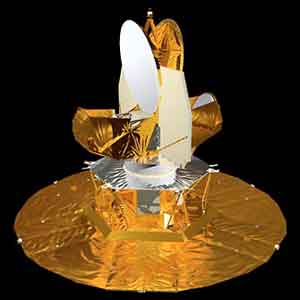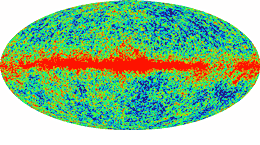Wilkinson Microwave Anisotropy Probe (WMAP): Difference between revisions
No edit summary |
No edit summary |
||
| Line 1: | Line 1: | ||
== Wilkinson Microwave Anisotropy Probe (WMAP) | == Wilkinson Microwave Anisotropy Probe (WMAP) == | ||
[[Image:Wilkinson1.jpg|thumb| | [[Image:Wilkinson1.jpg|thumb|right|A computer-generated rendering of the WMAP spacecraft. Courtesy: NASA.]] | ||
[[Image:Wilkinson2.gif|thumb|right|A simulation of the images we expect to see from WMAP. The red indicates regions that are slightly hotter than those shown in blue. The red band across the middle represents the Milky Way. Courtesy: NASA.]] | |||
Launched by NASA in June 2001 (and renamed in honor of world-renowned cosmologist David Wilkinson in late 2002), the Wilkinson Microwave Anisotropy Probe (WMAP) makes maps of temperature fluctuations in the [[Cosmic Background Radiation|cosmic microwave background (CMB) radiation]]. CMB radiation is the radiant heat that is believed to be left over from the [[The Big Bang and the Early Universe|Big Bang]], the primordial explosion that many scientists believe occurred about 12-14 billion years ago, and which gave rise to our universe. First observed in 1965 by [[Arno Allan Penzias|Arno Penzias]] and [[Robert Wilson|Robert Wilson]], the CMB contains a wealth of information about physical conditions of the early universe. In 1992 NASA launched the Cosmic Background Explorer (COBE) to learn more about CMB. COBE, however, had shortcomings that made it sensitive only to broad fluctuations in matter density and temperature. WMAP is more sensitive than COBE and, therefore, will map the CMB with greater sensitivity and higher resolution. | Launched by NASA in June 2001 (and renamed in honor of world-renowned cosmologist David Wilkinson in late 2002), the Wilkinson Microwave Anisotropy Probe (WMAP) makes maps of temperature fluctuations in the [[Cosmic Background Radiation|cosmic microwave background (CMB) radiation]]. CMB radiation is the radiant heat that is believed to be left over from the [[The Big Bang and the Early Universe|Big Bang]], the primordial explosion that many scientists believe occurred about 12-14 billion years ago, and which gave rise to our universe. First observed in 1965 by [[Arno Allan Penzias|Arno Penzias]] and [[Robert Wilson|Robert Wilson]], the CMB contains a wealth of information about physical conditions of the early universe. In 1992 NASA launched the Cosmic Background Explorer (COBE) to learn more about CMB. COBE, however, had shortcomings that made it sensitive only to broad fluctuations in matter density and temperature. WMAP is more sensitive than COBE and, therefore, will map the CMB with greater sensitivity and higher resolution. | ||
| Line 9: | Line 11: | ||
Scanning the full sky is an important part of WMAP’s mission. A major goal of the science of cosmology (the study of the nature of the universe) is to determine the statistical properties of the universe. Having more sky samples available gives scientists a much broader sampling of data then would otherwise be available. | Scanning the full sky is an important part of WMAP’s mission. A major goal of the science of cosmology (the study of the nature of the universe) is to determine the statistical properties of the universe. Having more sky samples available gives scientists a much broader sampling of data then would otherwise be available. | ||
The most prominent feature of WMAP is a pair of back-to-back telescopes that focus the microwave radiation from two spots on the sky roughly 140° apart and feed it to 10 separate differential receivers that sit in an assembly directly underneath the optics. Large “elephant ear” radiators cool the sensitive amplifiers in the receiver assembly. The bottom half of the spacecraft provides services necessary to carrying out the mission such as command and data collection electronics, attitude (pointing) control and determination, power services, and a propulsion system. The entire observatory is kept in continuous shade by a large deployable sun shield that also supports the solar panels, which power WMAP’s electronics. | |||
The most prominent feature of WMAP is a pair of back-to-back telescopes that focus the microwave radiation from two spots on the sky roughly 140° apart and feed it to 10 separate differential receivers that sit in an assembly directly underneath the optics. Large “elephant ear” radiators cool the sensitive amplifiers in the receiver assembly. The bottom half of the spacecraft provides services necessary to carrying out the mission such as command and data collection electronics, attitude (pointing) control and determination, power services, and a propulsion system. The entire observatory is kept in continuous shade by a large deployable sun shield that also supports the solar panels, which power WMAP’s electronics. | |||
[[Category: | [[Category:Components,_circuits,_devices_&_systems]] | ||
[[Category:Measurement]] | |||
[[Category:Electromagnetic_measurements]] | |||
[[Category:Fields,_waves_&_electromagnetics]] | |||
[[Category:Radio_astronomy]] | |||
[[Category:News]] | |||
[[Category:Nuclear_and_plasma_sciences]] | |||
[[Category:Radiation]] | |||
Revision as of 19:31, 6 March 2012
Wilkinson Microwave Anisotropy Probe (WMAP)
Launched by NASA in June 2001 (and renamed in honor of world-renowned cosmologist David Wilkinson in late 2002), the Wilkinson Microwave Anisotropy Probe (WMAP) makes maps of temperature fluctuations in the cosmic microwave background (CMB) radiation. CMB radiation is the radiant heat that is believed to be left over from the Big Bang, the primordial explosion that many scientists believe occurred about 12-14 billion years ago, and which gave rise to our universe. First observed in 1965 by Arno Penzias and Robert Wilson, the CMB contains a wealth of information about physical conditions of the early universe. In 1992 NASA launched the Cosmic Background Explorer (COBE) to learn more about CMB. COBE, however, had shortcomings that made it sensitive only to broad fluctuations in matter density and temperature. WMAP is more sensitive than COBE and, therefore, will map the CMB with greater sensitivity and higher resolution.
As its name suggests, the specific goal of WMAP is to map the relative CMB temperature over the full sky. Critical to WMAP’s success is ensuring that systematic errors (like those resulting from design flaws, which could undermine the accuracy of the entire project) are avoided. To achieve its goal of mapping CMB temperature fluctuations, WMAP uses differential microwave radiometers that measure temperature differences between two points in the sky. WMAP will observe the sky from an orbit about 1.5 million kilometers (about 932,000 miles) from Earth. WMAP uses an L2 orbit as its permanent observing station. L2 is a semi-stable region of gravity about four times further away than the moon. This vantage point offers an exceptionally stable environment for observation since the observatory can always point away from the Sun, Earth, and Moon while maintaining an unobstructed view to deep space. WMAP will scan about 30% of the sky each day and will observe the full sky every six months.
Scanning the full sky is an important part of WMAP’s mission. A major goal of the science of cosmology (the study of the nature of the universe) is to determine the statistical properties of the universe. Having more sky samples available gives scientists a much broader sampling of data then would otherwise be available.
The most prominent feature of WMAP is a pair of back-to-back telescopes that focus the microwave radiation from two spots on the sky roughly 140° apart and feed it to 10 separate differential receivers that sit in an assembly directly underneath the optics. Large “elephant ear” radiators cool the sensitive amplifiers in the receiver assembly. The bottom half of the spacecraft provides services necessary to carrying out the mission such as command and data collection electronics, attitude (pointing) control and determination, power services, and a propulsion system. The entire observatory is kept in continuous shade by a large deployable sun shield that also supports the solar panels, which power WMAP’s electronics.

